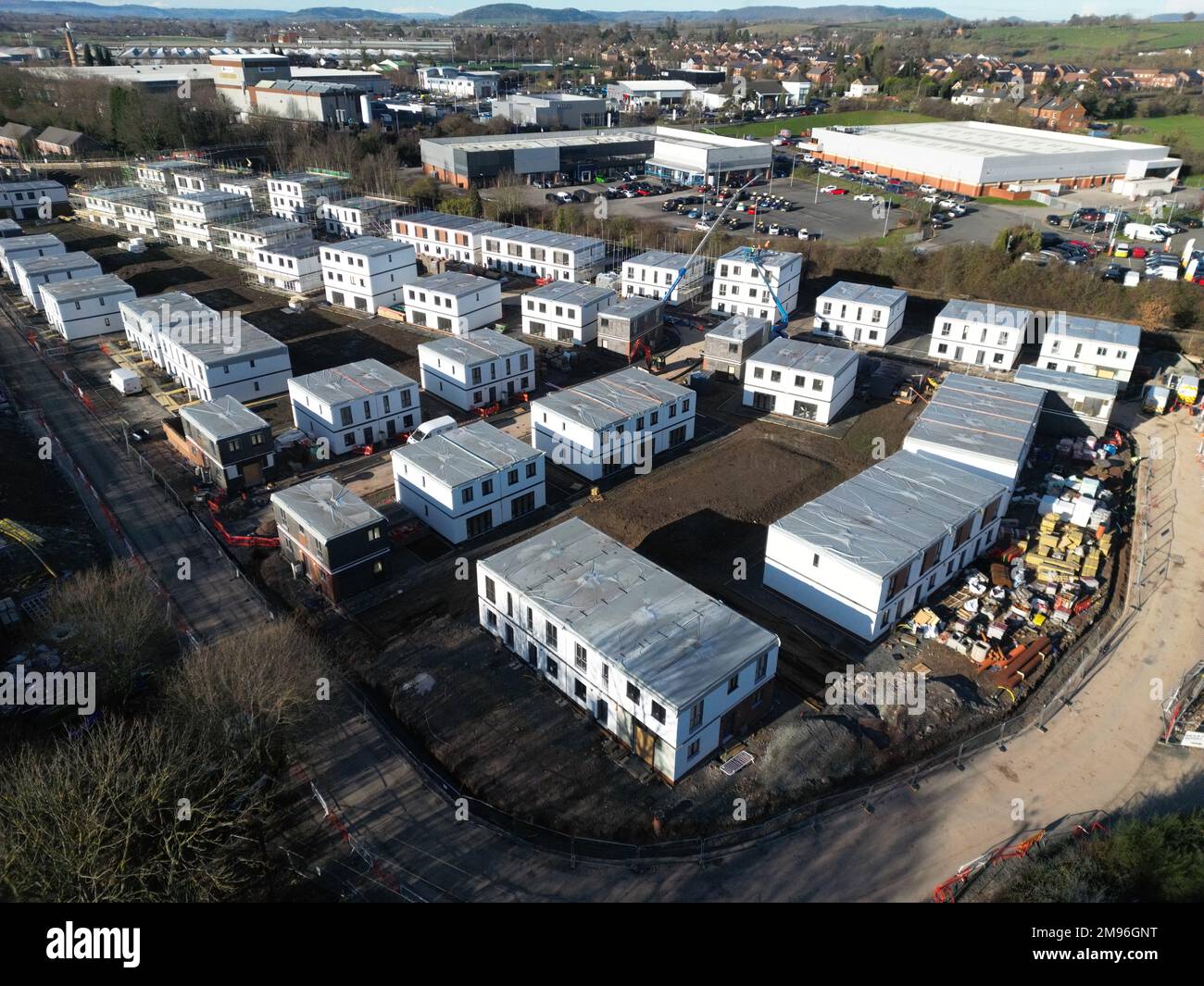Discover how modular construction is transforming Britain’s building landscape, delivering homes in half the time of traditional methods while slashing costs by 30%.
Understanding Modular Construction: A Modern Building Revolution
Modular construction represents a paradigm shift in how Britain builds homes, marking a decisive break from traditional construction methods. At its core, this innovative approach involves manufacturing building components in controlled factory environments, rather than traditional on-site construction. This revolutionary method is proving to be a game-changer for the UK’s construction industry, particularly as it grapples with housing shortages and increasing demand for sustainable building practices. Recent studies show that modular construction can reduce build times by up to 50% and cut costs by nearly a third compared to traditional methods.
The Basic Principles of Modular Construction
- Pre-fabrication of building components in controlled factory settings
- Standardised production processes ensuring consistent quality
- Climate-controlled manufacturing environment eliminating weather delays
- Parallel construction of modules and site preparation
- Rapid on-site assembly of pre-made components
How Modern Factories Are Reshaping Construction
Today’s modular construction facilities in the UK are highly sophisticated operations, employing cutting-edge technology and automation. These modern factories utilise advanced Building Information Modelling (BIM), robotics, and precision engineering to create building components that meet or exceed traditional construction standards. The UK has seen a 40% increase in modular factory capacity over the past three years, reflecting growing industry confidence in this approach.
The Economic Impact: Cost Savings and Efficiency
The financial benefits of modular construction are reshaping the economics of building in Britain. With traditional construction costs rising and skilled labour becoming increasingly scarce, modular methods offer a compelling alternative. Studies by the UK Construction Industry Council show that modular construction can reduce overall project costs by 20-30%, while significantly accelerating delivery times.
Breaking Down the 30% Cost Reduction
- Reduced labour costs through factory efficiency
- Minimal weather-related delays and disruptions
- Lower material waste and better inventory management
- Reduced site preliminaries and overhead costs
- Faster project completion leading to earlier return on investment
Time Efficiency: From Factory to Finished Home
The speed of modular construction is perhaps its most striking advantage. While a traditional house might take 6-9 months to build, modular homes can be completed in just 10-12 weeks. This dramatic reduction in construction time is achieved through parallel processing, where site preparation occurs simultaneously with factory fabrication.
Labour Optimisation and Skill Development
Modular construction is creating new opportunities for workforce development in the UK construction sector. Factory settings enable better training programmes, consistent work conditions, and the development of specialised skills. This approach is helping to address the industry’s skilled labour shortage while creating more attractive career paths for young workers.
Quality and Sustainability Advantages
The controlled environment of factory production leads to superior quality control and enhanced sustainability outcomes. Modern modular construction facilities in the UK are achieving remarkable standards of precision and environmental performance, with some projects reaching up to 90% less waste compared to traditional construction methods.
Superior Quality Control in Factory Settings
- Precision engineering and automated quality checks
- Consistent material storage and handling
- Standardised assembly processes
- Regular testing and inspection protocols
- Better moisture control and material protection
Environmental Benefits and Waste Reduction
Modular construction is significantly more environmentally friendly than traditional building methods. Factory-based production allows for better material recycling, reduced transport emissions, and minimal site disruption. Recent UK studies show that modular construction can reduce waste by up to 90% and lower carbon emissions by up to 50% compared to traditional construction methods.
Energy Efficiency and Future-Proofing
Modern modular homes are designed with energy efficiency in mind, often exceeding current building regulations standards. Factory-precise insulation installation and airtight construction contribute to superior thermal performance, resulting in lower energy bills and reduced carbon footprints.
Real-World Applications in British Housing
Across the UK, successful modular housing projects are demonstrating the practical benefits of this construction method. From affordable housing developments to high-end residential projects, modular construction is proving its versatility and effectiveness.
Success Stories from UK Developments
- Legal & General’s modular housing factory in Leeds, producing 3,500 homes annually
- Ilke Homes’ Yorkshire facility, delivering 2,000 homes per year
- Urban Splash’s House project, revolutionising custom-build homes
- Berkeley Group’s modular construction programme in Southeast England
Overcoming Traditional Construction Challenges
Modular construction addresses many traditional building challenges, including weather delays, labour shortages, and quality inconsistencies. The controlled factory environment ensures consistent quality while reducing dependencies on weather conditions and seasonal variations.
Integration with Traditional Building Methods
Many successful projects combine modular and traditional construction techniques, creating hybrid approaches that maximise the benefits of both methods. This flexible approach allows developers to choose the most appropriate construction method for each project component.
The Future of British Housing Construction
The future of housing construction in Britain is increasingly modular. Industry experts predict that by 2025, modular construction could account for 20% of all new homes built in the UK. This growth is driven by increasing demand for sustainable, affordable housing and the need for faster construction methods.
Emerging Trends and Innovations
- Integration of smart home technology during factory assembly
- Advanced materials and construction techniques
- Increased customisation options
- Digital twin technology for lifecycle management
- Sustainable material innovations
Regulatory Framework and Industry Standards
The UK government and industry bodies are developing comprehensive standards and regulations specifically for modular construction. These frameworks ensure quality, safety, and performance while facilitating wider adoption of modular building methods.
Making the Switch: Practical Considerations
For developers and homeowners considering modular construction, several key factors should be evaluated to ensure success. Understanding the planning process, choosing the right partners, and considering site conditions are crucial steps.
Key Factors for Developers and Homeowners
- Planning and building regulation requirements
- Site access and preparation needs
- Transport and logistics considerations
- Financial and insurance implications
- Future maintenance and modification potential
Finding the Right Modular Construction Partner
Selecting an experienced modular construction partner is crucial for project success. Look for manufacturers with proven track records, appropriate accreditations, and comprehensive warranties. Consider their capacity, experience with similar projects, and financial stability.
Transform your next construction project with modular building techniques – contact leading UK manufacturers for consultations and quotes.
FAQ
How much does it really cost to build a modular home?
The average price to construct a modular home is $270,000. For customization and additional features, you can likely plan to pay $10 – $150 per square foot. The price also varies based on the accessibility of the area where the home is to be delivered and put together.
Which is better, stick-built or modular?
Modular homes are built with the same materials as a stick built home, offer a controlled environment to assure a high quality construction, offer the same or more technological advances to improve the functionality, esthetics, and efficiencies of your home, offer the same financing options and rates as a stick built …
How long do modular homes last?
In most cases, modular homes are constructed using the same materials as site-built homes. And as you now know, they are subject to many of the same standards and regulations. As a result, you can expect modular homes to last for a long time—over 50 years in many cases.
Are modular homes worth it?
Is a modular home a good investment? A modular home can be a good investment. They often offer energy efficiency which is a selling point. However, a modular home’s value will be dependent on the housing market in your area, just as it would be with any other kind of home.
Sources
[1] https://www.modular.org/what-is-modular-construction/
[2] https://www.mckinsey.com/capabilities/operations/our-insights/modular-construction-from-projects-to-products
[3] https://en.wikipedia.org/wiki/Modular_construction


Leave a Reply